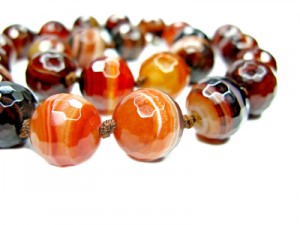August Birthstones - Wait, They Get THREE?!
Sardonyx
As its name suggests, Sardonyx is made up of alternating layers of two types of mineral chalcedony – sard, and onyx. Sources of this yellowish red to reddish brown gemstone include Brazil, Germany, Czech Republic, Slovakia, Madagascar, Uruguay, and the United States, with India being where the finest pieces have been unearthed.

Sardonyx was believed to be a symbol of strength and protection and was therefore found to be popular amongst warriors dating all the way back to the Second Dynasty of Egypt more than 4,000 years ago. It was also often used by the Romans as a seal or signet ring to imprint wax emblems on official documents because the wax easily came off without sticking to the stone. However, sardonyx was not a rare gemstone and therefore was not limited to only the wealthy. It was common and inexpensive enough that almost any jewelry collection could have it included.
Peridot
Peridot is, which can be easily spotted thanks to its lime green glow, is actually a rare variety of the more common mineral, olivine. Because it forms deep inside the Earth's mantle, it is found in and around volcanoes, whose eruptions and seismic activity tend to bring it to the surface. It can also be found inside meteorites. Most of the world's peridot comes from the San Carlos Reservation in Arizona, however, other sources include China, Myanmar, Pakistan, and Africa.

Jewelry featuring the peridot gemstone date back as far as the second millennium B.C. when the Ancient Egyptians believed it protected its wearer from the terrors of the night. There were also several historical mix-ups where peridots were mistaken for emeralds, one being Cleopatra's famed "emerald" collection, another the 200-carat gemstones adorning one of the shrines in Germany's Cologne Cathedral. More recently in the 1990s, the gem saw a revival when new deposits were found in Pakistan, unleashing some of the finest peridots the world has ever seen.
Spinel
Unlike the peridot which is typically only found in a bright lime green hue, Spinel can be found in several different colors, the most desirable being vivid red, followed by cobalt blue, bright pink, and bright orange, though the palette it comes in is even greater than that including black, lavender, violet-blue, and more. Significant deposits of spinel have been found in Cambodia, Myanmar, Sri Lanka, and Thailand.

As with the peridot, the Spinel is another gemstone that often gets confused with others as it tends to resemble either a ruby or sapphire. It, too, hasn't been given the credit it is due throughout history such as the "Black Prince's Ruby" and the "Timur ruby" in the Crown Jewels of England, which have been confirmed to be red spinels and not rubies at all. However, one member of the spinel group was well appreciated and that was the magnetite which has magnetic properties. Mariners as early as the 11th century would use this form to magnetize their compasses.
NOW YOU KNOW: August has choices galore when it comes to birthstones to choose from – sardonyx, peridot, and spinel. Each has its own history and story to tell. The question now is, which will you choose August babies?
For more information on how to get your hands on one of these spectacular gems, feel free to contact us!

